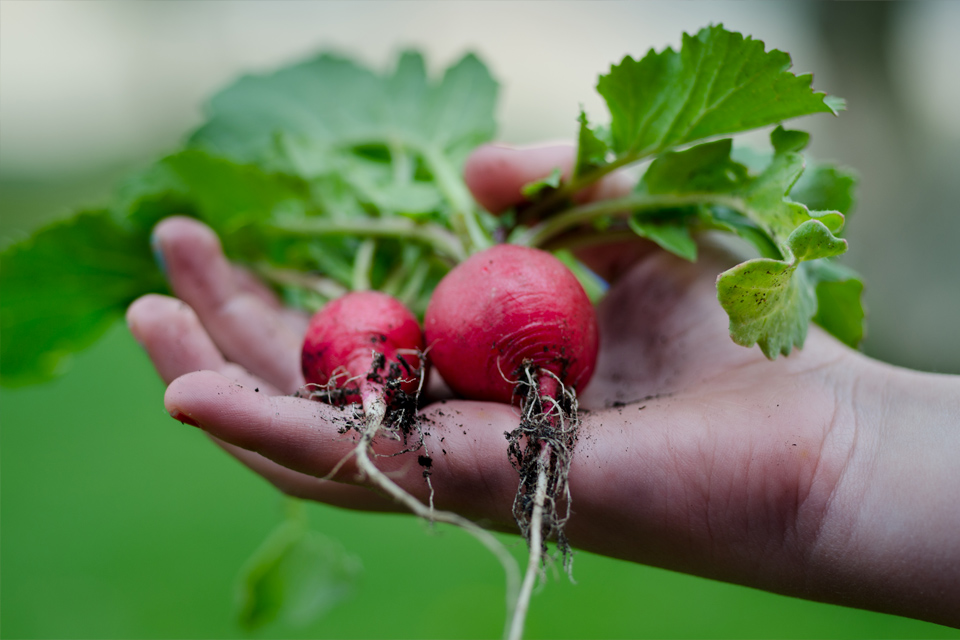
Gardening is fun, great exercise, and something you can do at any age! Some yard work like raking and carrying leaves will improve your endurance and strength, while other gardening activities can help increase and maintain flexibility. It’s also great for your mind! Working outside in the sunshine and fresh air is good for you and it provides an escape from the pressures of everyday responsibilities. Keep in mind though that gardening can be very hard work and there are both traumatic and repetitive strain injuries that can put an end to your gardening fun if you aren’t aware and careful.
Traumatic Injuries
Traumatic injuries are uncommon, but often more critical than strain injuries. Most traumatic injuries that occur while gardening are due to carelessness and improper use of tools. Follow the steps below to avoid these common causes of traumatic injury while gardening.
- Traumatic back injuries are usually caused by heaving lifting. The best way to avoid overstraining yourself is to get someone to help you lift and move the heavy item. If you do have to move a heavy item by yourself, keep the item as close to your body as possible, carry it in front of you, and keep your spine straight. Alternatively, if possible, roll the item to its destination or onto a piece of tarp and drag it.
- Avoid ankle sprains and injuries by wearing correct footwear for the job. Do not dig in sandals or soft shoes. Be aware of uneven ground, slippery surfaces, and obstacles.
- Wear heavy gloves, long pants, and a long-sleeved shirt to avoid scratches, cuts and punctures. Make sure you’re up to date on your tetanus vaccination (get one every 10 years). This bacteria can be difficult to eradicate once you’ve contracted it and it lives in soil and animal feces, and enters the body through open wounds.
- Be careful to avoid tripping which can lead to injuries such as fractures by putting equipment out of the way after using it. When using ladders and stepladders, position them correctly and secure them properly to avoid unbalanced falls. Wear a harness when pruning trees.
- Protect your head by keeping your tools tidy to avoid getting hit by standing on a hoe and wear a hard hat if you climb trees.
- Be extremely cautious with any gardening chemicals. Read the labels and follow the instructions. Make sure all containers are labeled and kept in a safe place away from animals and children. When spraying toxic substances, stand upwind of the spray and use a respirator with an appropriate filter (not just a dust mask). Better yet, avoid the use of toxic chemicals and start gardening organically!
- One form of the Legionellosis bacteria (which causes Legionnaires disease) lives in soils and compost, so it is important to avoid breathing the dust from bags of potting mix, planting mix, soil, and compost. This is a potentially deadly infection with flu-like symptoms of fever, chills, cough, muscle aches, headaches, tiredness, loss of appetite, and/or occasionally diarrhea and vomiting.
- Wear sunscreen and a wide-brimmed hat to protect your skin from the sun. Avoid dehydration by carrying a bottle of water with you while you garden.
- Power tool safety tips:
- Walk around the area where you will be working and remove any objects (e.g., rocks, metal, glass, or wire) that could damage equipment or cause injuries if caught and thrown by equipment, such as lawnmowers.
- Keep children away from power equipment. Teenagers should only be allowed to operate outdoor power equipment if they possess adequate strength and maturity to do so safely. A responsible adult should supervise them.
- Be sure that safety devices on the equipment are in place and functioning properly before starting work.
- Unplug electric tools and disconnect spark plug wires on gasoline-powered tools before making adjustments or clearing jams near moving parts.
- Handle gas carefully. Never fill gasoline tanks while equipment is operating or when equipment is still hot. Wipe up spills. Store gas in an approved container away from the house. Finally, never smoke or use any type of flame around gasoline.
- Never work with electric power tools in wet or damp conditions.
- Be sure that extension cords are in good condition and are the proper size for the electrical current capacity of the tool. Use a ground fault circuit interrupter (GFCI).
- Ask that people approach you from the front while you are using power equipment so as not to startle you.
- Hire a professional to do a job that requires equipment you are not confident using. If you do decide to do the job yourself, know how to operate the equipment safely and correctly.
Repetitive Strain Injuries
Repetitive strain injuries (RSI) are the more common type of injury from which gardeners suffer. The most important rule in RSI prevention is to never work through pain. You are likely to develop chronic pain if you push yourself beyond your limits. Therefore, listen to your body and stop doing what hurts. Keep your body conditioned, practice healthy habits, and use the right tools so you can be a safe and healthy gardener.
- Bending and Lifting
- When you lift heavy objects, squat and bend your knees, using your thigh and buttock muscles, not your back muscles. When you bend over with your knees locked, you’re actually picking up 50% of your body weight in addition to the weight of the object you’re lifting. Bending your knees puts far less pressure on your back.
- Keep the object close to your body and center of gravity. This will cause much less strain on your back and will allow you to keep your arms close to your body and comfortably bent.
- Stand upright when working at ground level or when using long-handled gardening tools such as hoes, spades and rakes.
- Contract your abdominal muscles when bending over to lift something heavy.
- Keep your feet apart rather than close together.
- Garden in raised beds if possible. Move close to the object you are working on.
- Carrying
- Use larger arm muscles rather than pinch-gripping heavy objects (like pots) with your hands. Hold them from underneath with your whole hand and keep the load close to your body.
- Use two hands for a balanced load, if possible. If not possible, trade off between your arms so that you don’t pull your body out of alignment, which stresses both the back and hips.
- Make more trips with lighter loads.
- Test the load before you carry it. If you need help, make sure you get it!
- Drop the load immediately if you find it’s too heavy.
- Reaching
- Work below shoulder level whenever possible to avoid strain on your back and shoulders. Use a ladder to bring yourself up to the level you are working.
- When you have to work above shoulder level, work for no more than five minutes. Holding your arms up and looking up causes tremendous strain on your neck.
- Take a break to stretch your neck and back muscles and perform another activity for a few minutes before returning to over head work.
- Use both arms whenever possible.
- Ground Work
- Never over reach. Move to the job and keep moving to be close to your work.
- Keep your elbows partially bent, especially when doing resistive activities requiring elbow strength.
- Avoid twisting the forearms back and forth repeatedly. Consider using a weeding tool.
- Keep your forearms in a neutral position (i.e. thumbs up).
- Always face your work without twisting.
- Keep your wrists in a neutral position (i.e., handshake position). Avoid deviating your wrists up, down and sideways. This is especially important when working against resistance.
- Hold objects with a light grasp for a short period of time. Avoid a tight, sustained grasp.
- Squat with your heels on the ground.
- Keep your back relatively straight, feet apart about a foot and toes pointed outward.
- If you can’t squat with your heels on the ground, kneel, or semi-squat (i.e., one leg squatting with heel on ground and the other leg kneeling.) Or even better, use a garden stool or bench.
- Other things to keep in mind
- Schedule jobs when it’s easier to do them. Moist earth is easier to dig in than dry, compact earth or soggy, saturated earth. Work in the shade; don’t force yourself to work in the sun on a hot day.
- Warmup before you begin. It’s recommended to include similar motions that you will be doing in your gardening activity during your warmup. Start with small movements and gradually increase to full range of motion. Do your stretches after you are warmed-up.
- Alternate tasks that require heavy or repetitive movement with tasks that are easier to do.
- Change positions, stand up, and stretch frequently while you are working. Stretch again at the end of the day, paying special attention to muscles you’ve used a lot.
- Keep tools close at hand and use the right tools for the right job, ensuring that they are well-kept (sharpened, cleaned) so that they will be effective.
- Knee pads or cushioning of some type will minimize the stress of kneeling and will protect your knees from the rocks and roots that dig into your bones.
- Spread the work out over several days or weeks. Start slowly and take frequent breaks. Don’t work until you wilt.
- Stay hydrated. Drink more water than you think you need.
Muscle Groups to Condition for Gardening
Please do not participate in any strengthening exercises if you already are experiencing pain from injury! If you are not sure the best way to exercise these muscles, please contact us for assistance in helping you develop the best program for your needs!
- Back. For lower back strength and flexibility, work on strengthening core muscles, especially all of the abdominals.
- Arms and shoulders. Activities in the garden require lifting, reaching overhead, and digging with a trowel that can result in strain injuries if muscles are weak. To prevent this, strengthen them and increase your flexibility by working on your biceps, triceps, chest, rotator cuff and forearm muscles. Do not do push-ups if your wrists hurt.
- Hands. The hands are used extensively in gardening. Hand strengthening exercises to increase grip strength consist of gripping and squeezing, but these exercises are not advisable for people who are experiencing any hand, wrist, or forearm pain. Instead, these people should focus on the stretches that will relax and lengthen these muscles and increase flexibility in these generally rigid body parts.
- Knees. Your knees are stressed when you squat or push a cart uphill. Strengthening and lengthening the quadriceps is important.
We wish you the best success with your garden this year! Please remember these safety tips for a great year of fun working in your garden and enjoying the fruits of your labor!
Source: Working-Well


